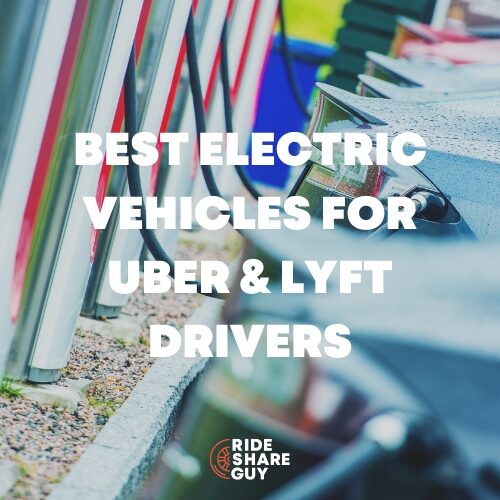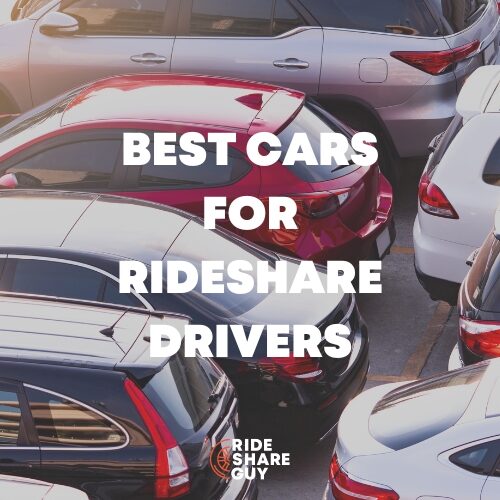“That’s not a Mustang!”
If you drive a Ford Mustang Mach-E long enough, you’ll hear this yelled from someone. And they’re right. A roomy five-passenger CUV just can’t be an iconic American pony car, no matter how many galloping horses and “Mustang” logos you slather it with.
We got that out of the way. If you can get over the poseur-ness of this car, you’ll find it’s more useful and maybe even more fun to drive than a two-door sports coupe, and let’s not forget the mantra of the Uber driver: you can’t see it when you’re inside (not that it’s an eyesore). How is it to drive, and is it good for rideshare work? Let’s find out.
Quick summary:
- The Ford Mustang Mach-E is good for rideshare drivers if you don’t make too many long-distance trips
- It’s roomy and comfortable – qualifies for Uber Comfort
- Getting your hands on it might be tricky!
What is a Ford Mustang Mach-E?
Watch Gabe’s video about the Ford Mustang Mach-E here: Ford Mustang Mach E Review | Great Car For Driving Uber?!
The Mustang Mach-E is Ford’s first mass-market long-range electric vehicle (EV). It was introduced in 2019, and the pushback from the automotive enthusiast world was swift, strong and predictable. But Ford didn’t care.
“It became readily apparent to the team that this car needed to be a Mustang,” said Ford’s EV brand director Jason Castriota when the car was launched, and Bill Ford himself said “It also signals to the world that we are dead serious about electrification.” Deal with it.
Features
The Mach-E sorta-kinda looks like a Mustang, if you squint and aren’t too close. At 186 inches, it’s actually over two inches shorter (and at 75 inches wide, a inch narrower) than the coupe.
The swoopy shape is sporty but not too aggressive, and you can see the design language in the long snout and teardrop-shaped rear—a myriad of galloping-horse logos are scattered around the car is there in case the shape isn’t clear enough. There’s even a hidden light that beams a Mustang logo on the ground next to the driver’s door. We get it—it’s a Mustang.
Inside, it’s a roomy and comfortable passenger vehicle—just right for rideshare. The rear seats boast over 38 inches of both legroom and headroom (yes, it’s Uber Comfort eligible) and 54 inches of hip room—three adult passengers can get in fine without feeling crowded or hunting too long for seat belts.
Once they figure out how to open the back doors—a small button on the B pillar pops them open—they can hop in with little trouble, even if they have size/shape/mobility issues.
The driver’s experience is nice as well. The seat has lots of power adjustment, the controls are familiar to people who have driven cars before, and there are plenty of cubbies and nooks to stash things.
I was impressed by how nicely the car was built. Some of the interior pieces were a little flimsy and cheap-feeling, but I thought it all felt and looked well made and built to last, if not quite up to $45,000-car standards.
Under the Hood
Under that long, muscle-y hood there’s a big empty front trunk, and under the metaphoric hood is enough power to claim that Mustang badge from a performance perspective.
The all-wheel drive (AWD) and rear-wheel drive (RWD) models with the standard-range batteries (75 kWh) make 255 horsepower; the AWD with its two motors makes 417 foot-pounds of torque, more than the V-8 Mustang GT. Go deeper in debt for the extended-range (91 kWh) battery and horsepower goes up to 332 for the AWD, 282 for the RWD, while torque numbers stay the same—for the big battery, acceleration at lower speeds stays the same but get over 100 mph and whoooosh!
Tech
Ford figured that folks in the market for a car like this would want lots of tech, so it’s pretty well equipped. The first thing passengers say after apologizing for how long it took them to figure out the doors is, “wow! Look at that screen!”
All trim levels get a 15.5-inch (remember when an 18-inch TV was a big deal?) touchscreen with a big volume knob hogging up a bunch of room at the bottom. As dumb as the knob looks, the screen is really great. It’s quick, responsive and well laid out.
The Ford’s infotainment is exactly what all modern cars should have, Elon. Yes, it has wireless phone charging, Bluetooth connectivity with an app and phone-as-a-key connectivity, as well as Apple CarPlay and Android Auto.
It’s not the much-ballyhoo’d (and deservedly so) Android Auto operating system, just the standard Android Auto that’s been in just about every single new car since 2018 or thereabouts, Elon. The AA operating system is coming for some 2023 Ford vehicles but can’t be retrofitted to the 2021s and 2022.
Photo: Ford
Packages and Pricing
The Mustang Mach-E comes in three configurations—Select, Premium and GT. There was a “California Route 1” package, but it likely won’t be available next year, and the GT is a high-performance version that starts at $61,995 and packs some serious performance—probably not the pick of a rideshare driver.
The remaining two trim levels offer a lot and all versions start under $50,000. The Select base model is $43,895 (all prices are for the 2022 models—I’d expect the 2023 to go up in price, and don’t forget to add $1,100 for destination charges). Add $2,700 for AWD and $6,000 for the extended battery, which is only available on the $49,100 Premium trim.
The Premium pretty much comes loaded with the good stuff—19-inch wheels, glass roof, heated rear seats and steering wheel, upgraded sound system—but the Select has vegan-leather upholstery, that grande touchscreen, all the active and passive safety features the other versions get and available AWD. The only thing I’d want that you can’t get on the Select is that big battery, but more about that later.
Driving a Ford Mustang Mach-E: How Does it Do for Rideshare Drivers?
From the moment that solid door chunks shut, the Ford is a familiar, but fun and satisfying experience. The AWD with standard-battery version I tested was very zippy, with plenty of torque to get me ahead of traffic when I needed to.
You can pick from three performance levels. Whisper gives you smoother acceleration, Engage (try saying it like Jean-Luc Picard) is a bit jerky but more fun and unbridled…unbridles all the Mustang’s ponies and even pipes in a low, grumbling motor noise to the car’s audio system, which is cheesy but fun. I had this car all the way to go-to-jail speeds and it kept wanting to go faster. I’ve driven the GT version (which, if you want AWD and the extended battery is only $4,000 more than a similarly equipped Premium, so what the hell), and it’s insanely fast. As Oscar Wilde said, all things in moderation, including moderation.
It can be scorching fast, but it’s also a very civilized city car. The ride is soft but not too mushy (the GT gets race-quality adaptive suspension), steering is light (if a little numb feeling) and the brakes are firm and controlled.
I also liked how it felt more like a sedan than a crossover, not tippy or lurchy in turns. Potholes and speed bumps that would torture my guests in my regular car were much less noticeable, at the price of making the car a bit squishy, especially under hard braking. If you don’t give your passengers a smooth and comfortable ride in this car, it’s because you don’t like them.
And it’s quiet. Not high-end luxury quiet, but a lot quieter than my Tesla Model 3 and quieter than most gas-powered cars. My impression of driving the car reminds me of how a company like Ford, when it wants to build a good car, can build a really good car.
On the tech front, Ford is behind companies like Tesla, Lucid and Rivian, but the Mach-E is a car first, and a tech platform second—and I could feel it.
Passenger Feedback
One plus (or minus, if you’re a misanthrope) about driving an EV for rideshare is passengers love asking about your car. About a quarter of my Chevy Bolt passengers asked about it, half ask about my Tesla, but almost every passenger wanted to know about the Mach-E.
They liked the roomy cabin (though one passenger said he felt cramped), giant screen, sleek design and smooth, quiet ride. I’d like to say it boosted my tips, but it didn’t (nor does driving my Tesla).
The only real problem with using this car for rideshare is the wonky door opening. I thought my Tesla took the cake for confusing passengers, but Ford was like, “hold my beer!” Instead of a handle, the Ford has a quarter-sized button on the C pillar. Press it and the door pops open, and then the passenger pulls the edge of the door to open it enough to climb in.
The button is lit up at night, but it’s hard to notice in daylight—eventually, most people figure it out, but I still had to occasionally lower the rear window and explain the procedure for some.
Getting out, I thought it would be easier, as there is an actual mechanical handle, but maybe because the passenger now expects some kind of secret-squirrel door-opener, they don’t know what to do.
Even more passengers had to ask how to get out than how to get in. After five months of explaining to passengers how to get in and out of the Model 3, I can tell you it gets old fast.
Living with It
Life with a Mach-E should be pretty easy. The tech works well—it was easy and fast to pair my phone to the Bluetooth and CarPlay, and getting set up on Ford Plus worked well, too.
Ford Plus is key, because it is actually a key, so you don’t need to have your fob with you and it lets you access most of the different DCFC stations using a single app. Not as seamless as Tesla’s superchargers, but pretty close—and it’s only going to get closer as Electrify America, Chargepoint, EVGo and the other companies keep expanding (and hopefully improving) their networks.
Speaking of charging, you’ll need to do it daily at a minimum. The standard-range AWD car I drove is rated at 210 miles by the EPA, but forecasted 190 miles, likely due to the owner’s driving style and cool (for California) weather—warmer temperatures have brought the estimate back up to 205.
Independent testing has shown these cars generally meet or exceed the EPA estimate, unlike some other brands, Elon. The RWD standard range is now estimated at 247 miles, the AWD is at 224, while the extended range should see 303 and 277 miles. An important caveat: cold weather can really sap EV range and slow down charging—if you live in a snowy climate you should keep this in mind.
More important than range is efficiency, and the EPA estimate for the standard-range RWD is 33kWh per 100 miles – not great, but not the worst either. This means you’ll have a shorter range and use more electricity than a more efficient vehicle with the same-sized battery. Will that work for you? Look at your mileage logs and see if you frequently exceeded the maximum range.
When you do have to charge, the Mustang is capable of 150-kW fast charging. It can add 100 miles in a very short amount of time; maybe 10 or 20 minutes, depending on your state of charge, battery size and the charger you’re using. If you want to charge past 80 percent, the system slows the rate to 12 kWh, about the speed of level 2. That means for long trips you’ll be making a 40-minute charge stop every 180-200 miles after your initial full charge.
As a rideshare driver, I think the Mach-E is just fine; if the car will go roughly 250 miles (for the RWD) on a charge and you can add another 150 miles or more in a 30-minute break, that’s 350-400 miles in a day, far more than the average driver uses. Remember that Uber and Lyft bonuses are almost never mileage-based; why do you want to drive long distances to make 60 cents a mile? SMTMC!
Maintenance is minimal, even compared to other EVs. Aside from tire rotations, it’s an annual safety check, a cabin air filter now and then, and new transmission fluid and battery coolant many years in the future. Ford is kind of down on the list reliability-wise, though, but the battery warranty is eight years and 100,000 miles and you can get an extended warranty.
How do I get one?
Well…this could be tough. Bad dealership experiences, large mark-ups, and now, a closed ordering queue can make getting one expensive and difficult. However, this should be a useful review because I think that Ford will make a lot of these cars, for at least four or five model years, and successive improvements will make those cars better than the one I drove.
To find one, you can use the Ford website or a site like Autotrader. Be flexible—you likely won’t find the options or colors you want—and you’ll find one.
The dealer markup is probably non-negotiable, but you might have a trade-in car they really want (hybrids are hot right now) or have a personal connection to Ford or someone at a dealership. Keep in mind that you’ll also be eligible for some big incentives—$7,500 as a tax credit and an average of about $2,000 in local incentives, as well as the $4,000 (paid out at $1 per ride) Uber is offering at least through the end of 2022.
That’s $13,500, a lot more than most dealers are marking it up, and that’s before the $200 or more in fuel savings you’ll see each month.
Conclusion
If you had two questions about the Mach-E—how is it for rideshare and how does it compare to similar vehicles—I hope I’ve answered them.
The Mach-E is a good rideshare vehicle for the right driver, someone who can charge at home on a Level-2 charger and drives less than 350 miles a day. Compared to other EVs, I think it’s pretty good, with a nice balance of value, range, performance and comfort, with all the slick tech you’d want.
It’s a big investment but one that will likely pay off—and you’ll have a nice place to work. Happy driving!
Would a Mach-E work for your situation? Let us know!
-Gabe @ RSG





